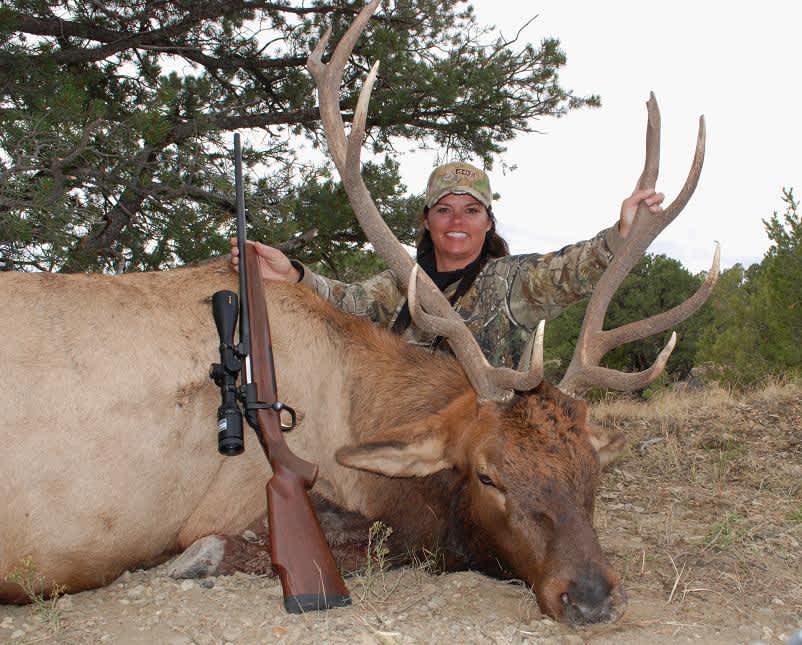Chasing the Bugle: Preparing for Elk Hunting
Lisa Metheny 09.14.11

Thanks to groups such as the Rocky Mountain Elk Foundation and the Mule Deer Foundation, more hunters have the opportunity to experience the thrill of hunting elk. Elk hunting can quickly turn into an obsession and when the conditions are right and all your plans come together, it is one of the most thrilling experiences a hunter may ever experience.
Elk hunting is challenging and often requires planning before you head to the mountains, especially if you’re a rookie. One of the first things a hunter must take into consideration is the physical demands of this type of big game hunting.
Hunting elk can be physically taxing on the body. Normally, you are dealing with elements outside your everyday comfort zone. You may also find yourself going from zero to sixty straight up the side of a mountain in order to get ahead of the herd. And let’s not forget the adrenaline pumping through your system if you are lucky and find yourself into serious action. Add in fatigue, altitude, and weather and elk hunting warrants you be in good physical condition.
Altitude sickness is dangerous and can quickly ruin your hunt if you don’t listen to your body. Incorporating an extra travel day or two before your hunt begins may give your body extra time to acclimate to the surrounding environment. Keeping well hydrated is vital when hunting at higher altitudes and loading up on carbohydrates a few days prior to your hunt will also help, as will avoiding caffeinated or alcoholic beverages.
Typically, elk prefer to move during the early morning hours just before sunrise and late evening hours right at dusk, especially if the weather is hot. But when the rut is in full swing, anything goes at anytime of the day or night. Getting up early in order to reach a vantage point before the elk are moving may be key to filling your tag.
Another key element to successful elk hunting is glassing. Experienced elk hunters know glassing for extended periods of time often produces results, especially in big country. A good spotting scope is a must. Veteran elk hunters suggest you take it slow first start with broad glassing of the region followed by carefully examining the dark shadows, timber areas, and pockets. Spending time behind the glass can spare a hunter useless hours of walking.

Controlling your scent is essential when hunting elk. There are many products claiming they work, some work, many do not. There is one line of clothes I have found which give a hunter a better chance of total scent control and it is the silver based Scent-A-Way Tek 4 clothing line. It works by preventing the bacteria that produces odor from growing, therefore giving a hunter a fighting chance. Still, an elk hunter has to be particularly sensitive about the direction of the wind, odors, and scents from other influences. Using products such as Hunter Specialties Scent Away spray, wipes, and even their scent wafers can help you fool a wapiti’s nose.
Elk have thicker hides and heavier bones, not to mention they often weigh 3 or 4 times more than an average whitetail, so picking a weapon that will provide the knock-down power is critical. Even bowhunters need to be aware of the differences in the two cervids mentioned. Experts recommend shooting a heavier arrow tipped with an razor sharp fixed blade broadhead and using the highest poundage a hunter can consistently shoot. Gun hunters should pick a firearm and ammo combination that is specifically designed for bigger game such as a Browning 300 WSM or .338 chambered with bullets using 180 grains or better.
Few things are more satisfying than harvesting an elk. And few things are tougher than field dressing, quartering, and carrying out your own elk. As with every aspect of elk hunting, being prepared will spare you headaches later. Like all meat, elk meat should be cooled down as quickly as possible. It may seem like an overwhelming task, but it doesn’t have to be. Don’t let the fear of field dressing an elk keep you out of the field. There are several DVD’s that provide excellent step by step instructions. One important note you should also be aware of is that in some states you will need to provide intact evidence of the sex of the elk, so it is crucial to know the laws before you begin.
Thanks to conservation groups, landowners, and dedicated hunters, the future of elk in this country look promising. Hopefully, as the elk herds continue to flourish there will be more opportunities for hunters to experience the sights, sounds and thrills of chasing the bugle.

